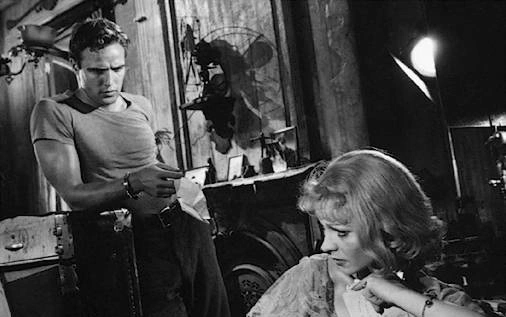Marlon Brando Marlon Brando (1924-2004), American actor known for his use of the naturalistic "method" style of acting (see Stanislavsky Method).
Publié le 12/05/2013
Extrait du document

Marlon Brando Marlon Brando (1924-2004), American actor known for his use of the naturalistic "method" style of acting (see Stanislavsky Method). Despite an inconsistent career, Brando is widely considered to be one of the most gifted and influential actors of his generation. Marlon Brando, Jr., was born in Omaha, Nebraska, where his father was a salesman and his mother was an actor in local productions. As a young man Brando moved to New York City, where he studied the acting theories of Russian theater innovator Konstantin Stanislavsky at the New School's Dramatic Workshop and later at the Actor's Studio. He made his Broadway debut in I Remember Mama in 1944. But it was the role of brutish Stanley Kowalski in A Streetcar Named Desire (1947), by playwright Tennessee Williams, that made Brando a star. The role brought the actor to the attention of the film industry. He portrayed Kowalski in the 1951 film version of the play, earning his first Academy Award nomination. Brando subsequently demonstrated his versatility in a number of other motion-picture performances, including the role of Mark Antony in Julius Caesar (1953). He received an Academy Award for best actor for his performance as a longshoreman in On the Waterfront (1954). Brando's other early films include Viva Zapata! (1952), The Wild One (1954), Guys and Dolls (1955), and The Teahouse of the August Moon (1956). In 1961 he directed and appeared in One-Eyed Jacks (1961), a critical and commercial failure. The following year Brando acted in Mutiny on the Bounty (1962). During the remainder of the decade he became known for his unconventional choice of film roles. These included The Ugly American (1963), Morituri (1965), The Chase (1966), Reflections in a Golden Eye (1967), and Queimada (Burn!, 1969). Brando returned to the forefront of Hollywood with his performance as Mafia boss Don Vito Corleone in The Godfather (1972), for which he won his second Academy Award for best actor. (He refused the award as a protest against the film industry's treatment of Native Americans.) Brando turned in a critically acclaimed performance in Last Tango in Paris (1972), but the film was controversial for its sexual themes. Over the last three decades of his life, Brando appeared in relatively few movies. He had small roles in Superman (1978) and Apocalypse Now (1979). In 1989 he appeared in the antiapartheid film A Dry White Season, set in South Africa. The Freshman (1990) was a comedic parody of his Godfather role. Other films with Brando included Don Juan de Marco (1995), The Island of Dr. Moreau (1996), Free Money (1998), and The Score (2001). Microsoft ® Encarta ® 2009. © 1993-2008 Microsoft Corporation. All rights reserved.
Liens utiles
- Acting I INTRODUCTION Lee Strasberg American acting teacher Lee Strasberg was best known for his association with the Actors Studio, of which he became the artistic director in 1951.
- Clark Gable Clark Gable (1901-1960), American motion-picture actor, best known for his portrayal of Rhett Butler in the film Gone with the Wind.
- Henry Fonda Henry Fonda (1905-1982), American actor, best known for his convincing portrayals of characters of integrity.
- Paul Newman Paul Newman, born in 1925, American actor, entrepreneur, and philanthropist who won an Academy Award for his role in The Color of Money (1986).
- Jerry Lewis (entertainer) Jerry Lewis (entertainer), born in 1926, American motion-picture actor and director, known for his screwball comedies.































